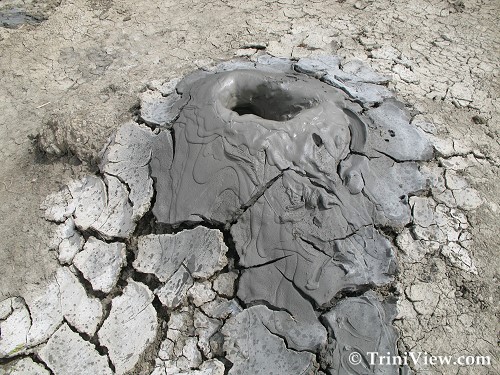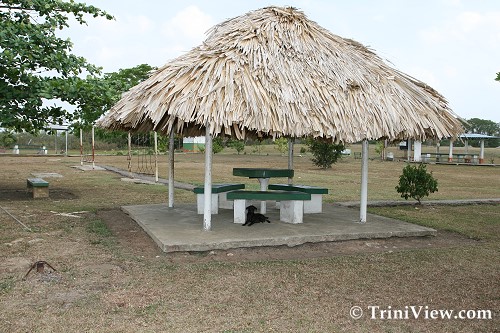 A Small Mud Volcano in Devil's Woodyard
A Small Mud Volcano in Devil's Woodyard
TriniView.com Reporters
Event Date: May 19, 2007
Posted: May 24, 2007
The Devil's Woodyard, an area of mud volcanoes, lies in the area of Hindustan, near Princes Town. A mud volcano is a mound of watery mud or clay, forced out of the earth by methane gas. These volcanoes can either spew material with violent force, causing damage or simply release a mild surface upwelling of muddy water accompanied by gas bubbles; this is the more common occurrence. These volcanoes are sometimes known locally as "bouffe" (French for swelling), "morne" or "yard." The original Amerindian inhabitants of Trinidad called these areas 'guaico', meaning, "mud-stream". When the mud is of the dry type, a conical or volcano shape is usually formed. Wet mud tends to result in depressions.
The Hindustan area, where this volcano is located, lies amid rolling low hills and wide plains charred now with the effect of fires brought on by the extreme dry season. The landscape is noticeably clayey and cracked in places, but it is a peaceful area, almost eerie in its stillness, yet quite breezy and refreshing with few houses and people walking or traveling along the road.
 The Devil's Woodyard Natural Park
The Devil's Woodyard Natural Park
The site itself of this natural landmark appears quite innocuous on first approach. It is a wide park with a few benches and gazebo-type thatched roof huts probably erected by the corporate entity that maintains the area. As we walked further into the park, however, the grass gave way to cracked, dry, grey earth that looked as though when wet, would make the area quite tricky to navigate. This covers a wide expanse of the area, with cracks in some areas large enough to make walking tricky going. Soon, several small mounds of grey mud are visible, from a few feet to a few inches in height. Most were quite dormant now but with some evidence of recent activity. We could see fresh mud on the side of some cones with dry caked mud on others. Some cones still bubbled occasionally with grey mud that was cool to the touch. In other areas medium sized pools held grey muddy water, which still bubbled occasionally indicating that gases were still escaping the vents. It was quite interesting to observe and eagerly anticipate the chance bubble of the mud and to observe the few times it accumulated to the point that new mud would roll down the sides of the small cones and form new layers.
As we made our way back over the tricky cracked terrain we observed a plaque placed at the entrance to the natural landmark that gives this history of the area and the origin's of its curious name:
This relatively young volcanic site got its name after its first eruption in 1852 which shook the entire village, felled tall trees and frightened villagers. The Amerindians, at the time being superstitious, believed that the devil had come out of the earth and felled the woods. The mounds of earth with occasional bubbles of grey matter oozing out, and the rumbling, hissing sounds that terrified villagers continue to be a wonder to all who visit this site.
Other accounts claim that the name originated with early European settlers who thought the sound of the gas erupting sounded like the devil stockpiling wood underground to tend his fires. It is also said that some Hindu devotees consider it a holy place and worship at the Devil's Woodyard site.
(Source: http://www.trinoutdoors.com/pages/other%20places.htm#Mud%20Volcanoes)
Journey to Devil's Woodyard in pictures:
www.triniview.com/gallery/main.php?g2_itemId=178447
Homepage | Special Events | Photo Gallery
|
|
